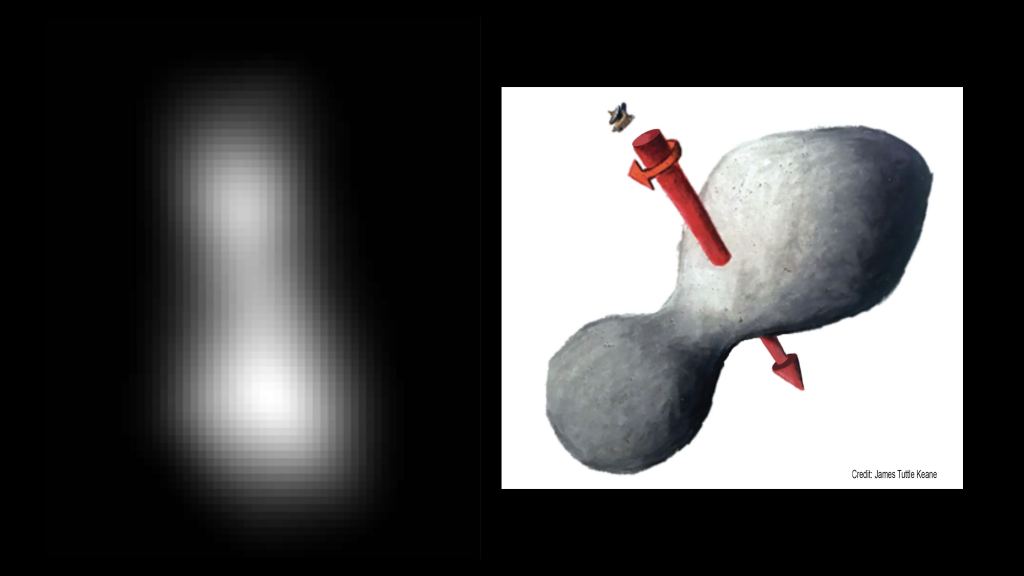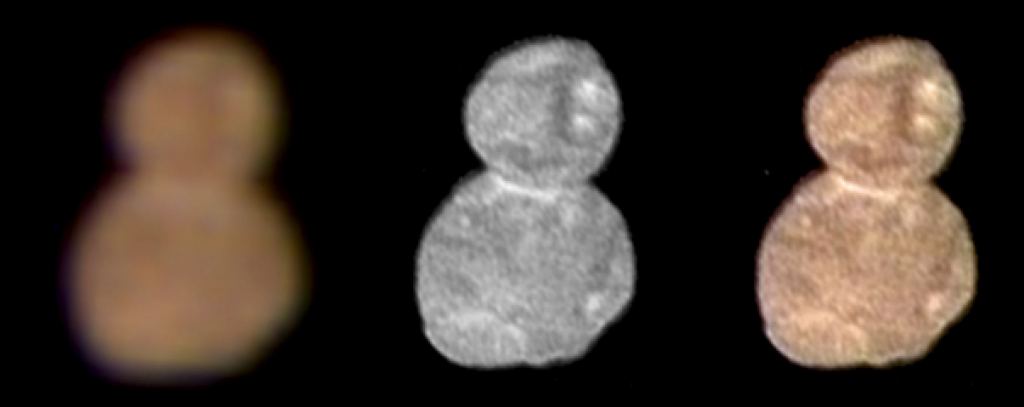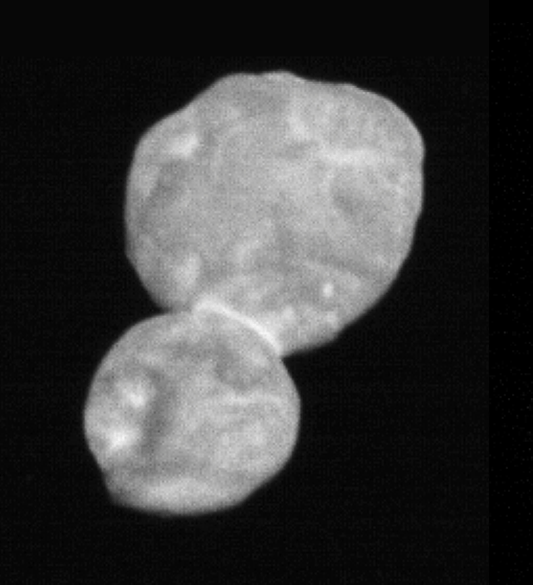On December 31st, 2018, NASA and the New Horizon‘s team (plus millions of people watching the live stream at home) rang in the New Year by watching the New Horizons mission make the first rendezvous in history with a Kuiper Belt Object (KBO). About thirty minutes after the probe conducted its flyby of Arrokoth (2014 MU69), the mission controllers were treated to the first clear images ever taken of a KBO.
Since the first approach photographs were released (which were pixilated and blurry), the New Horizons team has released new images from the spacecraft that show Ultimate Thule in color and greater detail. It’s appearance, which resembles that of a snowman, beautifully illustrates the kinds of processes that created our Solar System roughly four and a half billion years ago.
The first image (shown at top), was taken by the spacecraft’s Long-Range Reconnaissance Imager (LORRI) at 05:01 UTC (01:01 EDT) on January 1st, 2019. The image was taken when the spacecraft was 28,000 km (18,000 mi) away, or just 30 minutes, away from making its closest approach to Ultima Thule. It was also a vast improvement over images snapped the day before, which provided more hints about Ultima Thule’s shape and rotation.

As Alan Stern, the principle investigator of the New Horizons mission from the Southwest Research Institute (SwRI), said in a recent NASA press release:
“This flyby is a historic achievement. Never before has any spacecraft team tracked down such a small body at such high speed so far away in the abyss of space. New Horizons has set a new bar for state-of-the-art spacecraft navigation.”
The new image also resolved the debate about the nature of Ultima Thule. Initially, the New Horizon‘s team believed that the object was a spherical chunk of ice and rock measuring 18-41 km (10-30 mi) in diameter. However, after an occultation observation that took place in Aug of 2017, the mission team revised this prediction.
From then on, the mission team was of the mind that Ultima Thule was actually a large object with a chunk taken out of it (an “extreme prolate spheroid”) or two objects orbiting very closely together or touching (a close or contact binary). The new images revealed that the object is in fact a contact binary, consisting of two spheres that measure 31 km (19 mi) from end to end.
Meet #UltimaThule! What you’re seeing is the 1st contact binary ever explored by a spacecraft. This object, which we can now see is a contact binary, used to be 2 separate objects that are now bound together. Watch for more @NASANewHorizons science results https://t.co/ZuxLDtzW9c pic.twitter.com/uF9VfgN4Fh
— NASA (@NASA) January 2, 2019
The team has dubbed the larger sphere “Ultima”, which measures 19 km (12 mi) in diameter, and the smaller sphere “Thule” (14 km; 9 mi). They also claim that the two spheres are likely to have come together very shortly after the formation of the Solar System. By their estimates, this would have happened about 4.45 billion years ago, or 50 million years after the Solar System formed.
As Jeff Moore – the New Horizons Geology and Geophysics team lead – explained it, this means that Ultima Thule is basically a preserved record of the Solar System’s ancient past:
“New Horizons is like a time machine, taking us back to the birth of the solar system. We are seeing a physical representation of the beginning of planetary formation, frozen in time. Studying Ultima Thule is helping us understand how planets form — both those in our own Solar System and those orbiting other stars in our galaxy.”
The team also shared a color photograph of Ultima Thule (shown below), which was taken at 04:08 am UTC (12:08 am EDT) on January 1st, 2019, when the probe was 137,000 km (85,000 mi) from Ultima Thule. This image was taken by the craft’s Multispectral Visible Imaging Camera (MVIC), which combines light from the infrared, red and blue channels.

The color photo was then combined with the image taken by the LORRI camera (which has nearly five times the spatial resolution of the MVIC) to produce a detailed image that shows the color uniformity of the Ultima and Thule lobes. The improved resolution also draws attention to the object’s “neck”, where the two lobes are connected.
In the coming weeks and months, data from the New Horizons’ flyby will continue to be received by the mission controllers. Included in this will be a series of much higher-resolution images that will provide an even greater look at Ultima Thule, currently the farthest object from Earth to ever be photographed by a spacecraft.
As Helene Winters, New Horizons’ Project Manager, indicated, it won’t stop there. “In the coming months, New Horizons will transmit dozens of data sets to Earth, and we’ll write new chapters in the story of Ultima Thule — and the solar system,” she said.
Further Reading: JHUAPL


This is exciting! What are the next steps for new horizons after that? What’s the next object they’ll potentially aim at? Cheers!